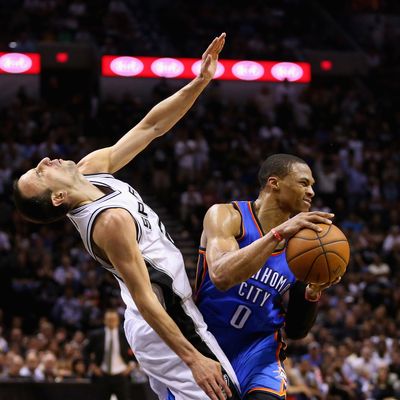
Ah, the flop: That play basketball fans love to hate in which a player, having gotten himself between, say, LeBron James and the hoop a bit too late to play actual effective defense, instead hurls himself backwards upon contact with James with the force of a thousand medieval catapults, hoping the ref will interpret this dramatic bit of performance art as an offensive foul on James. A lot of the times, it’s pathetically obvious, and when refs don’t make the call, the player is left on the ground, useless to his team, so recent research out of Ben-Gurion University of the Negev confirms what many NBA fans already know: Flopping doesn’t usually work.
For the study, published in the Journal of Economic Behavior and Organization, the researchers had referees and coaches observe, with the benefit of slow motion and multiple angles (two benefits in-game refs don’t have, of course), 501 plays from the Israeli Super League.
The results, from the paper’s abstract:
It seems to be helpful at first, increasing indeed the chances to get an offensive foul, but a more careful analysis shows that the entire impact of an intentional fall on the team seems to be negative. We suggest that both rational reasons and biased decision making lead players to frequently act against their team’s interest by falling. Referees almost never call an offensive foul if the player remained on his feet, and are generally calling fewer fouls than the number judged by experts as appropriate.
In other words, refs calling games in real time seem aware that flopping takes place, and the knowledge biases them against making calls that maybe, with the time and hindsight offered up by a replay monitor, they would. “Overall, the player is barely able to mislead the official and draw the offensive foul with a flop successfully in less than 10 percent of the time,” explained Elia Morgulev, a Ph.D. candidate at BGU who authored the study, in the press release. “So in the other 90 percent, the flopping player is simply left lying on the ground, leaving his team with four active defenders instead of five while the game goes on. Our methodical analyses of game outcomes in those cases reveal that flopping does more harm than good from the defending team perspective.”
It isn’t necessarily the case that what happens in the ISL happens in the NBA, of course. But there are solid reasons to think that flopping is a universal phenomenon. And while I couldn’t turn up any studies about flopping in the NBA (I’ll update this post if anyone points me to one), the league has recognized the problem to the point that it recently instituted anti-flopping fines — albeit ones that are rather wrist-slappy by the standards of NBA salaries.
Long story short: Stop flopping, floppers.




